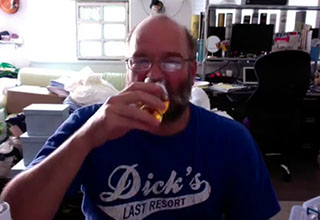
The morning of April 4, 1922, dawned upon the sleepy German hamlet of Kaifeck like any other - the ground was still cold from the previous winter's frost, the postman made his rounds, and friends and neighbors all rose to greet each other as they went about their day.
Before the day was done, however, a sequence of gruesome discoveries would set the whole town buzzing with rumors and accusations, eventually becoming one the most notorious cold cases in German criminal history.
Our story centers around a small farmstead known as Hinterkaifeck located less than a mile behind ("hinter" in German) the village of Kaifeck. The farm was occupied by 63-year-old Andreas Gruber, his wife Cäzilia (72), his widowed daughter Viktoria Gabriel (35), Viktoria's two children Cäzilia (7) and Josef (2), and the maid, Maria Baumgartner (44) - all whom were discovered on that fateful morning as victims of a brutal mass murder.

The bloody corpses of Andreas, Viktoria, and both Cäzilias were found buried under a haystack in the barn, while Maria and young baby Josef were both found murdered in their respective beds. All six victims had been bludgeoned to death with a mattock, a type of pickaxe used in farming. Despite multiple investigations over the subsequent decades and several arrests made, no suspect has ever been brought to trial due to lack of conclusive evidence.
On the surface, it may appear to be like any cold case, but it's the details surrounding the case that truly make the Hinterkaifeck incident so unique.

After examining the crime scene, it was determined that the victims were likely murdered on the evening of March 31, 1922 - several days before concerned neighbors discovered the bodies. Authorities found remnants of meals that had been recently cooked and eaten and neighbors had also reported seeing smoke from the chimneys, which is part of the reason they didn't stop by to check on the family until they did. This means that whoever murdered the Grubers made themselves right at home after they were done the killing, likely walking around the still-fresh bodies of Maria and baby Josef for several days as if they were little more than decorations. They also fed and tended to the farm animals, demonstrating at least some regard for life.
Police were also able to rule out robbery as a motive - although the Grubers were a decently wealthy family for the area, their money and valuables were left virtually untouched despite being fairly easy to find.
Then there's the fact that the Grubers' previous maid abruptly quit six months before the murders, having complained about hearing ghosts in the attic for several months before finally handing in her notice. Indeed, the new maid, Maria Baumgartner, had literally arrived at Hinterkaifeck for her first day of work on March 31, only to meet an untimely end a few hours later.

Curiously, there are some accounts from locals and neighbors that say 7-year-old Cäzilia had also made passing comments that the attic was haunted. Could it be that the killer was hiding out up there the whole time?
A few days before the murders, Andreas had also told some of the villagers about a set of footsteps he found leading from the forest behind the farm to the barn - but curiously, he could find no corresponding footsteps leading away from the property. He'd also noticed scratches on the lock to his tool shed - as if someone had attempted to pick the lock - as well as discovering a newspaper on the property that none of his neighbors subscribed to and that the postman had no recollection of ever delivering. Although his friends tried to give him a rifle for protection, Andreas seemingly thought little of these odd events and declined the offer.

Another curious and disturbing wrinkle to the case comes from the incestuous relationship between Andreas and his widowed daughter, Viktoria. Both Andreas and Viktoria had served jail time for it, and the fact that Andreas was sleeping with his daughter was an open secret around the community. There were even rumors that baby Josef was actually the product of this coupling - the boy was reported to bear a strong resemblance to his grandfather.
It's important to note here that Andreas Gruber was well-known to be an angry, ill-tempered man. Multiple villagers claimed his wrath was the reason that, although Andreas had multiple children with his wife, Viktoria was the only one who survived to adulthood. There is a strong possibility, therefore, that Viktoria was not an entirely willing participant in the relationship.
Whether it was consensual or not, one thing is clear - Viktoria fell pregnant with Josef not long after her father was released from prison, and her husband had already been reported as having died fighting for Germany in the trenches of WWI. There was, however, another candidate who could have been Josef's father - the Grubers' neighbor, Lorenz Schlittenbauer.
He had once engaged in a romantic relationship with Viktoria and had even tried unsuccessfully asking Andreas for her hand in marriage (Andreas declined as he was strongly against their relationship). After Josef was born, Viktoria had even sued him for child support! Lorenz tried to contest that charge at first, but eventually settled the matter and paid up.

Schlittenbauer was also among the first group of worried neighbors who decided to check in on the Grubers after none of them had been seen around town for several days. Upon arriving on the scene, the group first discovered the bodies in the barn, stacked up on top of one another and covered in hay. Schilttenbauer immediately started to un-pile the bodies - a serious breach of crime scene protocol, even in those early days of forensics. He also decided to go into the house on his own while the other members of his search party waited outside out of fear that the killer might still be on the scene.
When asked why he decided to barge into the house and further contaminate the crime scene, Schilttenbauer mentioned a fatherly concern for baby Josef and claimed that he was worried about the boy, even if he may not have been his own son.
Could it be that Schlittenbauer, heartbroken and publicly humiliated, decided to take his revenge on the family responsible for his troubles? His farm shared a property line with the Grubers', and he certainly had the opportunity, the motive, and the kind of agricultural knowledge that subsequent investigation determined the killer must've had. However, despite being questioned extensively by police, Schlittenbauer was acquitted as a suspect and went on to win numerous civil claims for slander against multiple people who kept saying that he was the murderer of Hinterkaifeck.

Another, more outlandish theory claims that the killer might've been Viktoria's dead husband, Karl. His body was never actually recovered, he'd never gotten along with Andreas, and he'd often made references to running away to Russia before his death. There were also German POWs in WWII who claimed they'd met a Soviet officer who spoke German and claimed to be the killer of Hinterkaifeck. It could be that Karl managed to fake his death, then returned home over seven years later to see that his wife had had another baby in his absence and killed everyone in rage. TThis theory holds little weight, however, since several of Karl's platoon members testified to having seen him fall in battle. His motive is also muddy - the farm was in Viktoria's name, so if he hoped to inherit it, he'd have had to officially come back from the dead.
Among other suspects were a pair of brothers whose sister claimed they did it on her deathbed and an escaped mental patient who may have been in the area roughly around the time of the murders, but police investigations couldn't find enough evidence to actually prove that any of them had done it.
A far more intriguing theory comes from writer Bill James and his daughter, Rachel McCarthy James. In their book, The Man From The Train, they claimed that the murders of Hintrekaifeck shared several key elements with another set of mysterious murders in America a few years prior. Much like Hinterkaifeck, the Villisca Axe Murders took place in an isolated home not far from a railroad track, saw an entire family murdered by a farming tool, and didn't include any form of robbery as a potential motive.

Based on his research, James says a German immigrant called Paul Meuller was likely responsible for the Villisca murders, and possibly fled back to Germany in the aftermath, where he resumed his murderous habits.
The murders at Hinterkaifeck remain unsolved to this day despite having been investigated multiple times by police, as well as true crime enthusiasts all over the globe.
In 2007, a German forensic academy had students investigate the case using modern techniques, but they determined that the absolutely horrendous techniques used by investigators of the time as well as the fact that the crime scene had been contaminated by curious townspeople (and Lorenz Schlittenbauer) and poor records made it virtually impossible to come to a conclusive answer. Although the students were able to narrow down the list of suspects to just one name, they never released that name out of respect for the person's living relatives.
If you'd like to dive deeper into the strange and mysterious events of Hinterkaifeck, check out the video below:






4 Comments